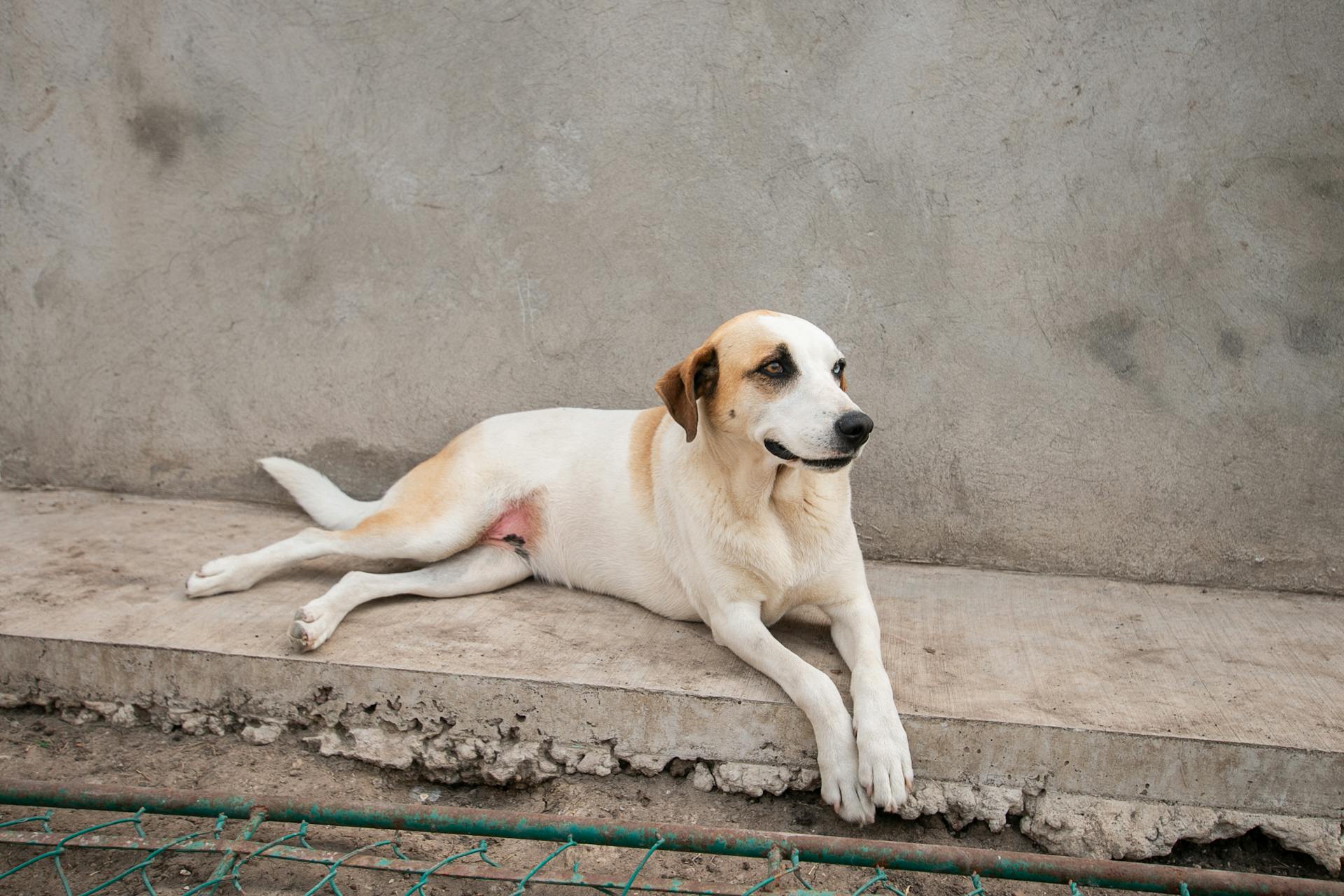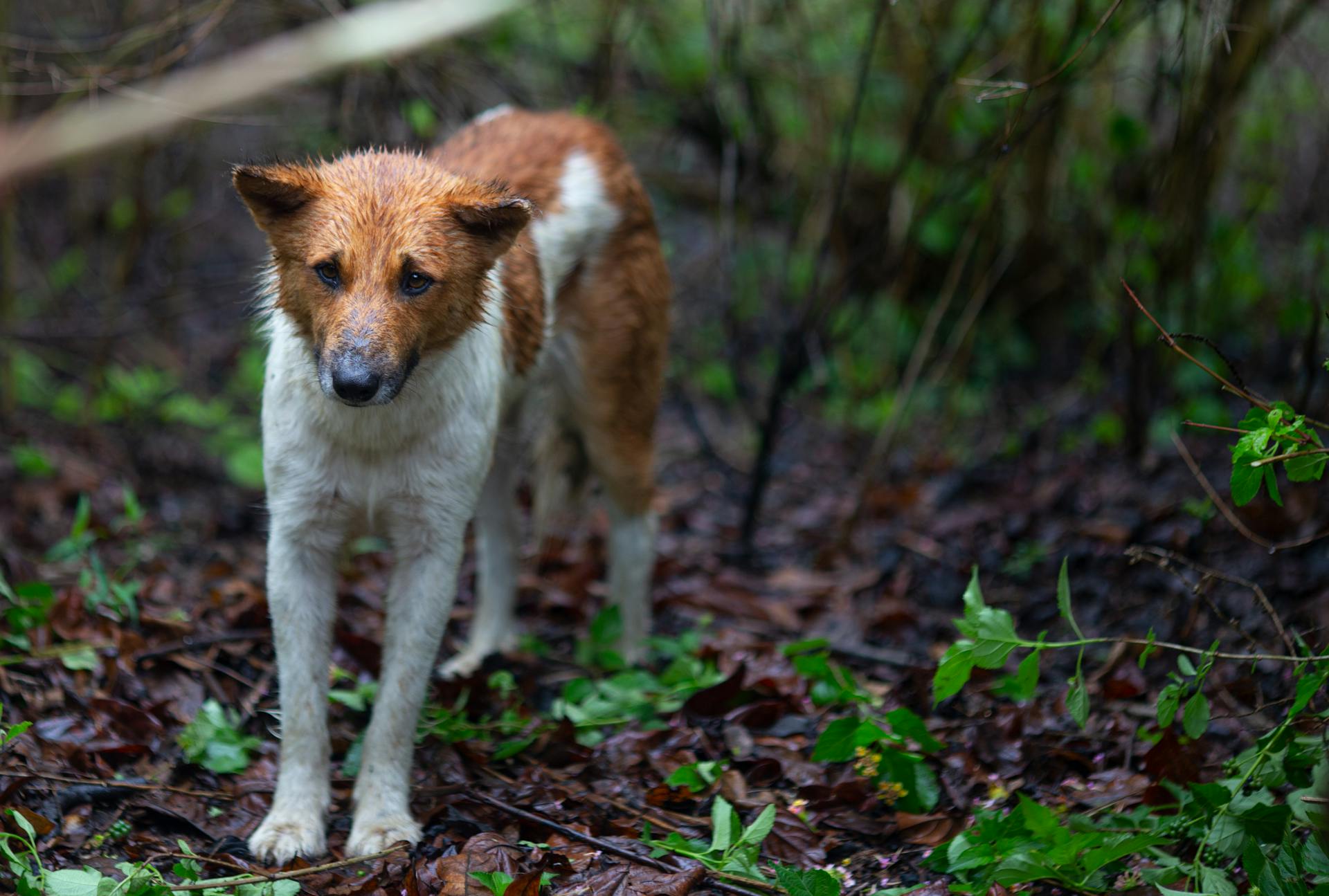
Feral dogs are often misunderstood creatures, but they can be helped with the right approach.
Feral dogs are not inherently aggressive, but rather, they're wary of humans due to their history of being abandoned or abused.
Their fear can be a major obstacle to helping them, as they may bite or run away if approached incorrectly.
Understanding their behavior and body language is crucial to building trust with feral dogs.
By recognizing signs of fear, such as raised hackles or a tucked tail, you can take steps to calm and reassure them.
Feral dogs can be socialized and even adopted into loving homes with patience and proper care.
However, their health can be a major concern, as they often lack access to veterinary care and may be malnourished or diseased.
Providing basic necessities like food, water, and shelter is just the first step in helping these dogs.
Rehab. Train. Thrive
Rehabilitating a feral dog requires patience, love, and a gentle approach. Feral dogs need time to trust humans and feel safe, so it's essential to start with small steps.
It's best to begin rehabilitating a feral dog in a quiet, enclosed area to minimize stress and prevent escape. This space should be free from distractions and provide a sense of security.
A typical rehabilitation process for a feral dog can take anywhere from several weeks to several months. The goal is to help the dog become comfortable with human interaction and eventually, live in a domestic setting.
Taming a feral dog requires consistent training and positive reinforcement. Rewarding good behavior with treats and affection helps build trust and strengthens the bond between the dog and its caretaker.
Socialization is a crucial part of the rehabilitation process, and it's essential to expose the dog to various environments, people, and other animals to help it become confident and calm in new situations.
Intriguing read: How to Become a Trainer of Service Dogs
Understanding Feral Dogs
Feral dogs are highly adaptable, social carnivores, and most are about the size of a coyote or slightly larger. They are capable of existing in the wild, but after a few generations of uncontrolled breeding, a generalized mongrel tends to develop.
Feral dogs are not always aggressive, but will protect themselves if confronted. They are extremely intelligent in regards to survival, very adaptive, and know no other way of life. They acclimate to their surroundings and take advantage of what is put in front of them.
Feral dogs are often born in the “wild” and have never had human contact. They live as any other wild creature, and do not know the life of a domesticated pet dog.
Biology and Behavior
Feral dogs are highly adaptable, social carnivores that can thrive in a variety of environments. They are often about the size of a coyote or slightly larger.
Their adaptability is one of their most impressive traits, allowing them to survive in areas with harsh winter weather. Feral dogs have even been known to survive in areas with limited food sources.
Feral dogs are highly social creatures and often live in family groups. These groups are more highly organized than previously believed, with multiple females sharing the responsibility of pup rearing.
In fact, studies have shown that feral dogs will even share the responsibility of raising pups born during autumn and winter, when food is scarce. This shared responsibility helps ensure the survival of the pack.
Feral dogs are also highly intelligent and resourceful, able to adapt to their surroundings and take advantage of available resources. They have even been known to use abandoned buildings or farm machinery as shelter.
Their ability to adapt and survive in the wild is a testament to their resilience and strength. Feral dogs are truly remarkable animals.
In the wild, feral dogs will often use former fox or coyote dens as shelter, or create their own burrows in the ground. These dens provide them with a safe and secure place to rest and raise their young.
Feral dogs are also highly territorial and will often defend their territory against other dogs. This territorial behavior is a key part of their social structure and helps maintain harmony within the pack.
Their ability to defend their territory is a testament to their strength and confidence. Feral dogs are not to be underestimated.
In fact, studies have shown that feral dogs will even exclude nonresident dogs from their pack, including females in estrus. This rigid social organization helps maintain the pack's stability and ensures the survival of its members.
Overall, feral dogs are highly intelligent, adaptable, and social creatures that are well-suited to life in the wild.
Identification
Feral dogs can be difficult to distinguish from domestic dogs in appearance, as they come in a variety of shapes, sizes, colors, and breeds.
Many feral dogs are descendants of domestic dogs gone wild and may resemble locally common dog breeds. German shepherds, Doberman pinschers, and collies are often among the breeds that become feral.
Feral dogs are primarily distinguished from domestic dogs by their level of dependence on humans and their behavior towards people. They survive and reproduce independently of human assistance.
Some feral dogs may use human garbage for food, but others hunt and scavenge like other wild canids. This independence is a key characteristic that sets them apart from domestic dogs.
Domestic dogs typically exhibit calm behavior when approached by humans, whereas most feral dogs show aggressive behavior, growling, barking, and attempting to bite.
Related reading: Dog Breeds Watch Dogs
Habitat and Distribution

Feral dogs are often found in forested areas or shrub lands near human habitation. Some people actively work to eliminate them from these areas.
They can also be found on lands with limited human access, such as military reservations and large airports. In these areas, they may feed on wildlife and native fruits.
Feral dogs are the most widespread of the wild canids, occurring wherever people are present and allow dogs to roam free or abandon them. This includes all 50 states, Canada, and Central and South America.
Home ranges of feral dogs vary in size, influenced by the availability of food. Dog packs that rely on garbage may stay close to a dump, while others may forage over an area of 50 square miles or more.
Dogs in the US
Dogs in the US are relatively rare as feral animals, but they do exist. They are often born in the wild and have never had human contact.
Feral dogs in the US typically don't live as long as their domesticated counterparts. They live as any other wild creature, without the life of a domesticated pet dog.
A truly feral dog should be approached with caution, just like any other wild animal such as a deer, fox, or bear.
Stray and Feral Dogs
Stray and feral dogs are often misunderstood, but they are two distinct types of dogs with different characteristics.
Feral dogs are incredibly intelligent and adaptive, living as self-sufficient wild animals that have never had human contact. They are confident in their dog skills and don't depend on humans for survival.
Feral dogs are typically found in areas with a strong presence of wild animals, and they often form packs with other feral dogs. They are not always aggressive, but will protect themselves if confronted.
In contrast, stray dogs have had contact with humans at some point in their lives and often struggle to care for themselves. They may have been abandoned, neglected, or lost, and as a result, their lives are much shorter than those of feral dogs.
Stray dogs often lack socialization with other dogs and may have poor dog language skills, making it difficult for them to join a feral pack. They are typically more fearful than feral dogs and may exhibit symptoms of fear such as snapping, biting, and avoidance.
Stray dogs can be rehabilitated with proper training and care, but it's essential to approach them with caution and patience. With a leader who can positively introduce them to the domesticated world, stray dogs can learn to trust humans and live happy, fulfilling lives.
Frequently Asked Questions
What is the difference between a wild dog and a feral dog?
A feral dog is one that has minimal human contact, while a wild dog is a feral dog that has evolved to be completely independent of humans over time. The key difference lies in the level of human interaction and the dog's adaptation to a wild environment.
Sources
- https://hart2heartcanine.com/fearful-feral-dogs
- https://www.thedevotedbarn.org/feral-dog-rehabilitation-program
- https://totalk9focus.com/rescue-dogs/feral-dogs-vs-stray-dogs/
- https://blog.companionanimalsolutions.com/wild-dogs-feral-dogs-and-pariahs/
- https://wildlife-damage-management.extension.org/feral-dogs/
Featured Images: pexels.com


